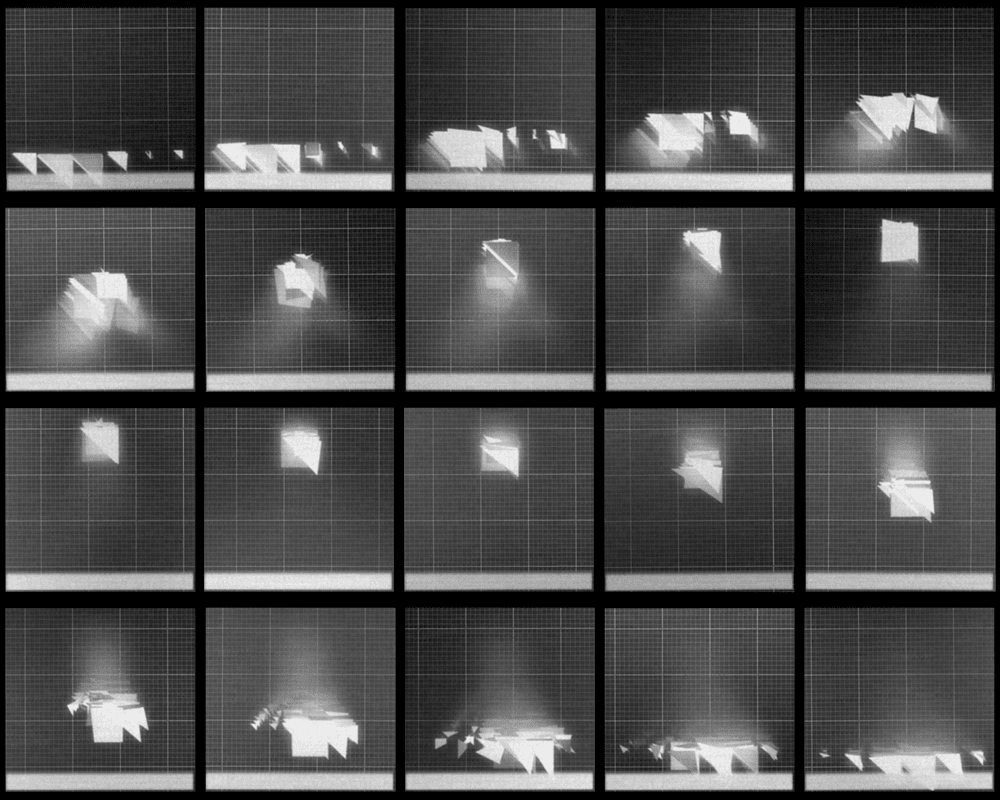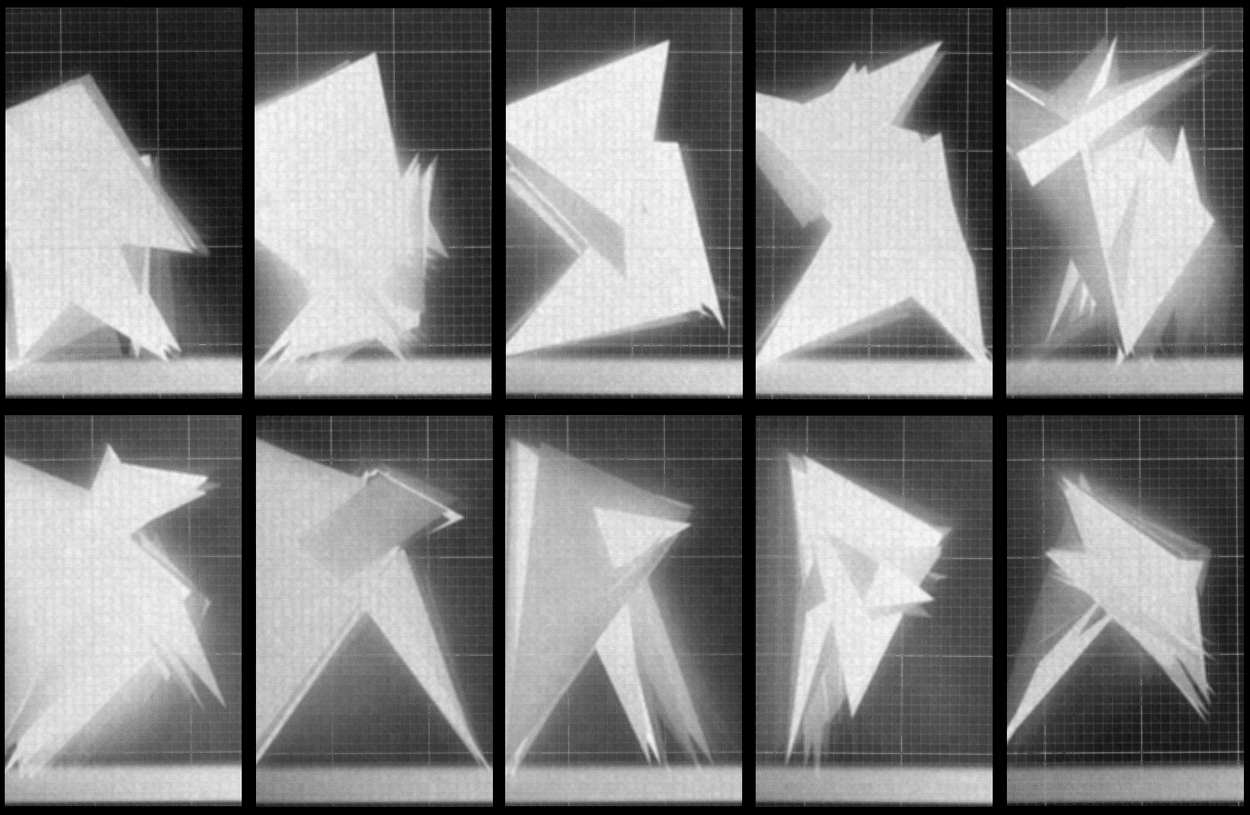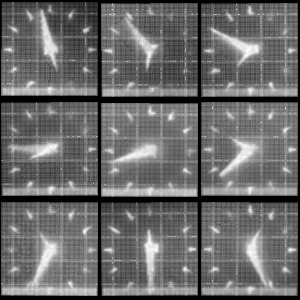The Hirsch Truth: Episode 7
Ann takes on generative art, reviewing projects by Kim Asendorf, Eric Hu, Anna Lucia, and others.

Generative art can be a way of creating a camera and its subject at the same time. Projects often consist of code that generates visual phenomena along with code that captures discrete images of those phenomena, like a camera photographing itself. In his 2023 projects Noumenon and Chronophotograph, the artist known as Deafbeef has pulled apart this metaphorical camera and subject just enough to show each element separately, and to draw some compelling historical parallels. These works were commissioned as a part of the “Remembrance of Things Future” initiative at the Los Angeles County Museum of Art, which invites contemporary digital artists to make works in response to pieces from the museum’s collection. Deafbeef chose the late nineteenth-century photographic sequences of Eadweard Muybridge, whose people and animals in motion have influenced thinkers and artists from Thomas Edison to Sol LeWitt. Muybridge’s groundbreaking camera sliced the fluid motion of real life into discrete sequences of images. Deafbeef extends this strategy to on-chain generative art, using Ethereum block numbers to seed generative outputs that mimic Muybridge’s grids.
Generative art can be a way of creating a camera and its subject at the same time.
Noumenon is a series of sixteen audiovisual works. Grainy black and white shapes pulse to a soundtrack of bleeps and bloops. The flickering shapes are produced by C code stored on-chain in the NFT smart contracts. Each Noumenon can be triggered to generate a Chronophotograph, a separate NFT whose grid of sequential still images metaphorically “observes” the pulsing randomness of the animation. The derivative works are created by executing a special command in the smart contract, which can be done either by the owner of the Noumenon or by another address that the owner can delegate. Unlike the Noumena from which they derive, the Chronophotographs use a different generative code that often produces semi-abstract forms evoking flying birds, running animals, or walking people that are not visible in the animation. While in theory an infinite number of these “observations” can be produced, there’s a catch. Creating a Chronophotograph from a Noumenon triggers a time-lock so that the process cannot be repeated immediately. The length of the time-lock is programmed to double each time a new NFT is created, so that the wait times increase exponentially. The process is also set to double the resolution of the still images each time. For the outputs created far in the future, the images will be so large that they’ll exceed the capability of today’s personal computers.

The Noumena and Chronophotographs extend visual and conceptual threads that Deafbeef has employed for several years. In his series Synth Poems (2021), the artist created short electronic compositions generated by code stored entirely on-chain. To accompany the synthesizer tones, the NFTs also feature animated visualizations that recall the scribbling white lines of an oscilloscope. Entropy (2021) is another series of audiovisual NFTs, again grainy and desaturated, that are programmed to further degrade each time they’re transferred from one wallet to another. Deafbeef included a feature in the code of the smart contract that mimics the loss of fidelity that occurs when older forms of analogue media are copied. The common thread in these and other works by the artist is the use of simple code to embed within smart contracts artificial qualities imitating the characteristics of obsolete analogue media. The Noumena and Chronophotographs employ these same strategies, while creating a subject full of motion and the means by which to freeze this motion into grids of still images. The resulting works look like abstracted versions of Muybridge’s classic studies of motion, analogue photographs that predated the movie camera.
Muybridge was a rare hybrid artist/technologist whose work had an impact on the earliest inception of both Hollywood and Silicon Valley.
In her book River of Shadows: Eadweard Muybridge and the Technological Wild West (2003), Rebecca Solnit makes the case that Muybridge is one of the most important artists of the nineteenth century. Already an established photographer of the rapidly changing American West, Muybridge’s motion studies began when he received funding from railroad magnate and university founder Leland Stanford to study the gait of trotting horses. The images proved revolutionary, and helped inspire the motion picture camera, Marcel Duchamp’s Nude Descending a Staircase, No. 2 (1912), and even the bullet-time sequences in The Matrix films over a century later. Muybridge, Solnit argues, was a rare hybrid artist/technologist whose work had an impact on the earliest inception of both Hollywood and Silicon Valley. His contributions forever changed how we perceive art, technology, and time.

Referencing Muybridge with a generative, on-chain NFT project is not just a clever art-historical riff. Muybridge’s camera and the blockchain have more in common than it might seem. In the famous 2008 Bitcoin whitepaper describing the digital currency before it launched, Satoshi Nakamoto does not use the word “blockchain,” but instead describes a “timestamp server.” Bitcoin, and all the blockchains that followed it, are machines for recording the sequence of events in time. They are clocks. The true innovation, of course, was that these clocks could build a shared ledger of events (transactions) without the need for a central authority. The code doesn’t just keep time, it also prevents quickly spending the same money twice without the watchful eye of a government or bank.
Blockchains are machines for recording the sequence of events in time. They are clocks.
The paradox of Muybridge, Solnit observes, was that he used cutting-edge technology to stop time, rather than propel it forward. He captured the West in photographs, crystallizing nostalgic vistas before they changed forever. In a time of increasing speed and industrialization, he devised a way to freeze bodies in motion. Deafbeef’s work shares this tendency, embedding C–a decades-old coding language–into Ethereum smart contracts to render images that recall oscilloscopes, analogue tapes, and film.

Deafbeef’s Chronophotographs bear a resemblance to Muybridge’s grids, but more importantly, both artists work by devising systems that not only produce images, but also reflect the conditions of their making. For Muybridge, the images of galloping horses and walking nudes are also images that convey the innovation of the camera that produced them. The photos are images of time itself, picked apart and put on display as never before. Deafbeef draws attention to the blockchain’s status as a clock, staking its entire claim to value on its ability to reflect an irrefutably true sequence of events, like capturing the order of steps in a horse’s gallop. One crucial detail that warrants further reflection is the fact that owners can only capture more Chronophotographs at longer and longer intervals into the future, and that those images will become bigger and bigger. This feature gestures at the precarious future of blockchain technology itself. Deafbeef shows that the blockchain is a clock, but it’s a clock with an uncertain future. These systems are built with the theoretical possibility that they will be around forever, but previous technology shows this is unlikely to be the case. The legacy of Muybridge survives. His camera does not. Doubling the duration of the time-lock between captures is a way of calling attention to the risk that the project, and the Ethereum blockchain underlying it, may or may not exist years or decades into the future. Is the blockchain the future? Or is it an odd, libertarian-tinged diversion in the story of early twenty-first-century art and technology? Will we ultimately care whether a decentralized ledger solves the double spending problem without a central authority? Or will we continue to place trust, willingly or not, in institutions the same way we have for millennia? Either way, Deafbeef’s work is an honest reflection of the peculiar mix of hope and anxiety that define the current moment, which will hopefully echo not only a century backward, but forward as well.
Kevin Buist is a design strategist, curator, and writer based in Grand Rapids, Michigan.
